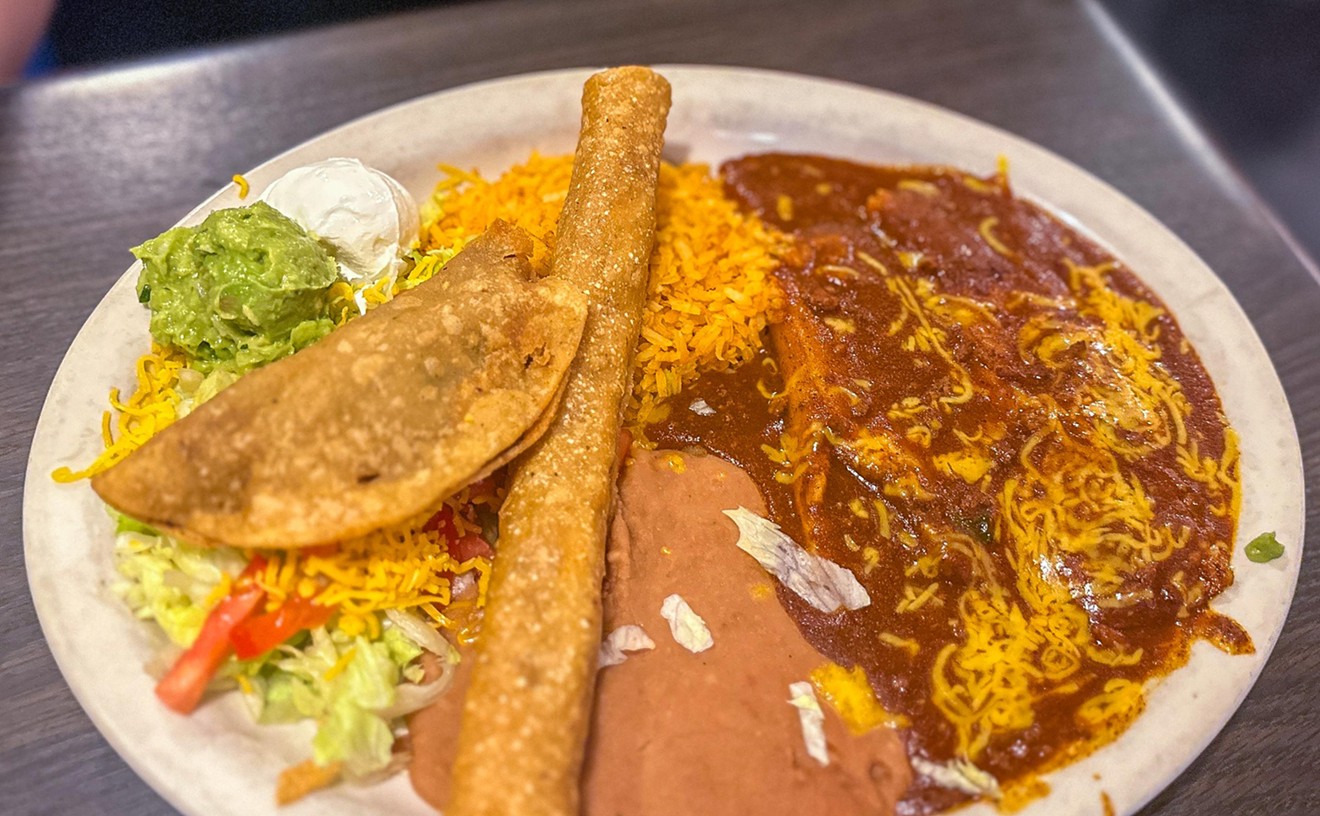Maybe that's why we didn't make reservations. Who goes out to eat at a fine restaurant on a wet night meant for parties and bizarre costumes? (We saw a guy in a straw boater with dozens of factory-fresh tampons dangling from the brim. How do these people get reservations?)
We certainly didn't think the weirdly dressed and the voyeurs of the Cedar Springs celebration would fill the dining room at The Landmark.
But then, pulling into The Melrose Hotel's parking lot, we are met by a cop with a clipboard and a flashlight. He motions for us to roll down our window. He seems annoyed that we dare covet his parking spaces. We just want dinner, we say.
That's when he starts getting intent with the clipboard, flipping through the saturated pages. "Name? I should have your reservation right here." He rolls his eyes when we tell him we were just trying our luck as hungry, disorganized stragglers. "Not a chance," he snaps. He motions us toward some orange cones blocking the drive that exits onto Cedar Springs. Another guy shuffles them out of our path.
But I still manage to snag one under my car, dragging the cone across Cedar Springs, shredding it into orange zest over Lemmon Avenue.
Funny thing, on a visit just a couple of days later, our waiter says the dining room thinned considerably after a mid-evening surge, which hit about the time we ran off with that cone. My timing, like my driving, was off. So we were resigned to sample the creations of newly installed Executive Chef Wiley Bates III on a pair of weekdays, when diners were sparse. Service was a little on the scanty side too, despite the lack of guests. Oh, there was plenty of gushy politeness. But there was no attentiveness to give those warm fuzzies some credible spine. A lot of "I'll be right with you after you've had a chance to review the wine list." But the "right with yous" seemed to hibernate behind a swinging door. And we were thirsty.
And hungry. Not many traces remain of former chef Jim Anile's often daring Asian touches. Anile, it seems, was brusquely swept out the door after the Berwind Property Group purchased The Melrose some months ago. A member of the U.S. Culinary Olympic team for more than two years, Bates was brought into The Melrose from the Great Southern Westin Hotel in Columbus, Ohio, another of Berwind's properties. While his work at The Landmark is nothing if not intriguing, it can also be a little perplexing.
Melrose propaganda makes hay over one of the more overtly novel creations. "There's also Wiley's innovative lobster-potato martini, named for the addition of sweet vermouth," says a letter itemizing the new dishes on the menu. Actually, Bates says the Yukon gold potatoes in his martini ($7.25) are folded with sweet vermouth. And while folding is a legitimate culinary term, the menu makes reference to other items that are folded. Tossed and tumbled too. I wondered whether our entrées would arrive in laundry baskets.
But the potatoes are served in a martini glass. The contents are pierced with a sprig of rosemary instead of an olive on a toothpick. Wiley admits to a fondness for strongly aromatic herbs such as rosemary. Many chefs feel this way, I think. I once talked to one who said the best meal he ever had was a roasted chicken, made by a few friends who sipped wine while battering the bird with rosemary branches.
Still, Bates' dish is odd. Also folded with clabber cream, these mashed potatoes spiked with sweet vermouth have strips of rock lobster meat -- not a harmonious combination to my taste. The coarsely textured potatoes clouded the sweet succulence of the lobster meat. Perhaps it's a metaphor for what a martini does to brain cells, but it comes off like lobster dipped in lint. It may have worked if the potato whip were lighter and creamier. Yet Wiley obviously is onto something: It's one of the best-selling items on the menu.
One item that should be flying off the menu is the tabil-spiced pork dumplings ($5.95), a tight trio of noodle pillows plopped in a puddle of citrus-sherry soy broth that begs for a spoon. Why would a restaurant fussily describe a broth on its menu then not provide a spoon so that the diner can fuss with it too? Bates' ruddy fluid is brisk, balanced, and savory. It's a perfect culinary backdrop for the tender dumplings, which are plump with moist, chewy, and well-seasoned pork. The dumplings are topped with crisp relish: julienne leek infiltrated with sesame seeds, fresh-squeezed orange juice, and orange zest. This is among the tightest, most well-orchestrated appetizers I've come across -- a little magnum opus in a bowl. And me without a spoon.
Caesar-style red romaine salad ($6.50) comes off well too. The dressing is potent. The flavors are visible. The leaves are well dressed, not flung limply across the plate, half naked and dull, or coated in some thick, shimmering white varnish to help the box-shaken croutons adhere. Instead of bread cubes, this salad is slipped with a deliciously potent piece of toast smeared with black olive tapenade. Plus, the Romano shavings are generous.
"My philosophy of food is melting-pot cuisine," Bates says. "I mean, it's a representation of the Americas. All walks of life, all nationalities are going to envelop the menu." Bates says he draws his inspiration from a decidedly different stock than Anile's creations displayed. Trained under German and Germanic-influenced chefs, Bates exhibits a huskier, fuller style. "I tend to favor cuts of meat that may not be prime cuts, and then make them taste good," he says. "You can get a 10-ounce filet anywhere." He takes this core and frames it with a variety of hues.
Bates' meat philosophy is illustrated in the venison osso bucco ($24.95). There's a lot going on with this gamy shank. First, it's cooked in a "hearty wine braise," which Bates says is Burgundy, maybe hearty Burgundy. There's diced tomato and other vegetables, a gremolata (a garnish made from parsley, lemon peel, and garlic), and a wild-mushroom marmalade. Even juniper berries come into play. Bates adds this for a kind of authenticity -- the animal nibbles berries, and he wants to include traces of flavor that might be found in the animal's muscle.
How does all of this come off in the mouth? There's little to clutch and relish. Sure, there's a residual sweetness, but the meat is washed-out. It has no venison raciness, no savory sauciness, no herbal swell. There's nothing to rescue it from the foundering flaccidity into which it seems to have sunk. Even a side of polenta, described on the menu as "creamy," was stiff, dry, and crumbly.
Far better is the veal loin chop au poivre ($31.50). Swimming in a dark, tarry rosemary jus, the meat is rich, tender, and chewy. While the sauce looked fiercely lumbering, it was actually concealing a crisp clump of crispy sautéed red cabbage. Also on the plate was a wedge of two-potato gratin, a flavorful bundle of thin, supple potato strands knotted together in surging cheese glue.
But while the sauce on the veal worked extremely well, the viscous slick pestering the hay-roasted Cornish game hen ($17.95) did little more than clobber this tough, dry midget chicken. The sauce, rendered from a balsamic vinegar reduction and laced with brown sugar, was simply too powerful and overwhelming to do anything but crassly needle the meat, even if it was roasted in freshly scythed hay.
This stands in stark contrast to Bates' risotto ($15.50), which was lightly creamy and elegantly subtle. With seasonal mushrooms and truffle oil to ground it in earthy whispers, scraps of prosciutto cut through its lush, grainy density.
Dessert faltered miserably. The Santa Fe tart with jalapeño and apricot glaze was fuzzy with lost flavors. It didn't cleanse. It didn't refresh. It didn't wash you with decadence. It just kind of laid there and played its weak little Southwestern strain.
The Landmark has taken a turn. But it's not only the food that's adjusting its course. The hotel is too. The circa-1924 building, designed by architect C.D. Hill, who also designed the Methodist church across the street, is in the final stages of a $3 million renovation (it was originally built as a residence and guest hotel at a cost of $2 million). This Dallas landmark is getting refurbished rooms and a ceiling mural in the lobby along with new furnishings and artwork. The dining room won't be spared either, which is good, because even though it's cleanly formal and has aged well, it's grown fitfully dull in the context of current Dallas dining-room fashion. Plus, the chairs are uncomfortable.
Bates describes the scheduled makeover as a "Maaco treatment," a superficial series of needed adjustments that promise to be undramatic. That's fine. This place wouldn't look good impersonating other highly stylized specimens in town. Save that level of mimicry for the spooks that creep over Cedar Springs every October.










